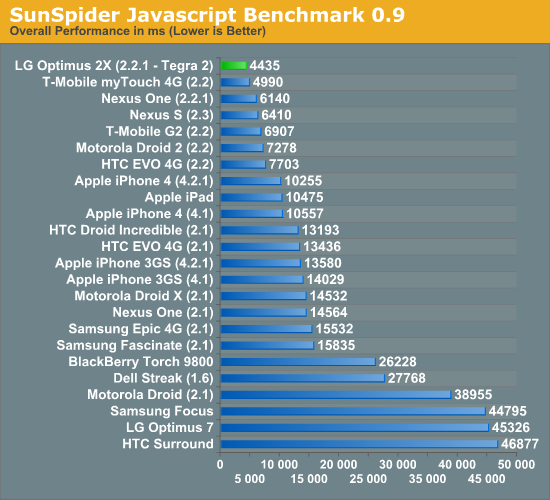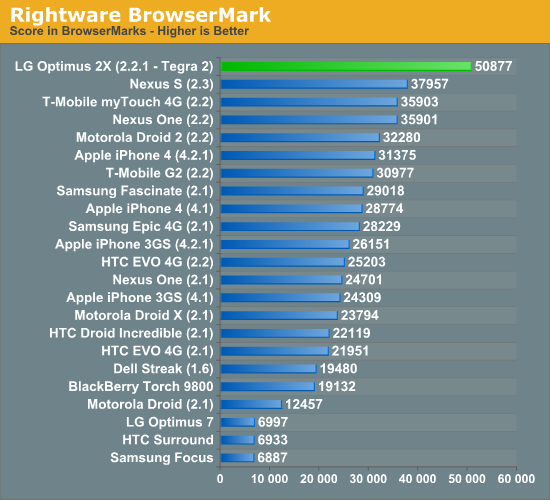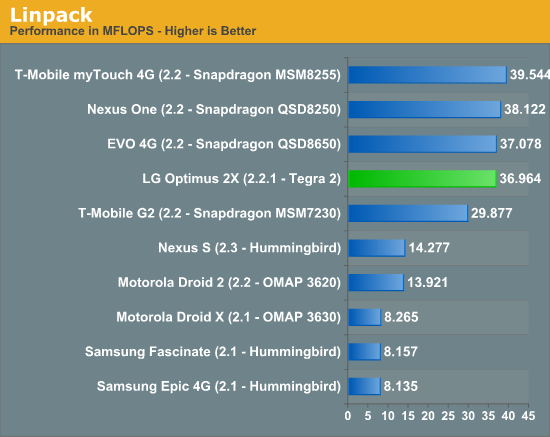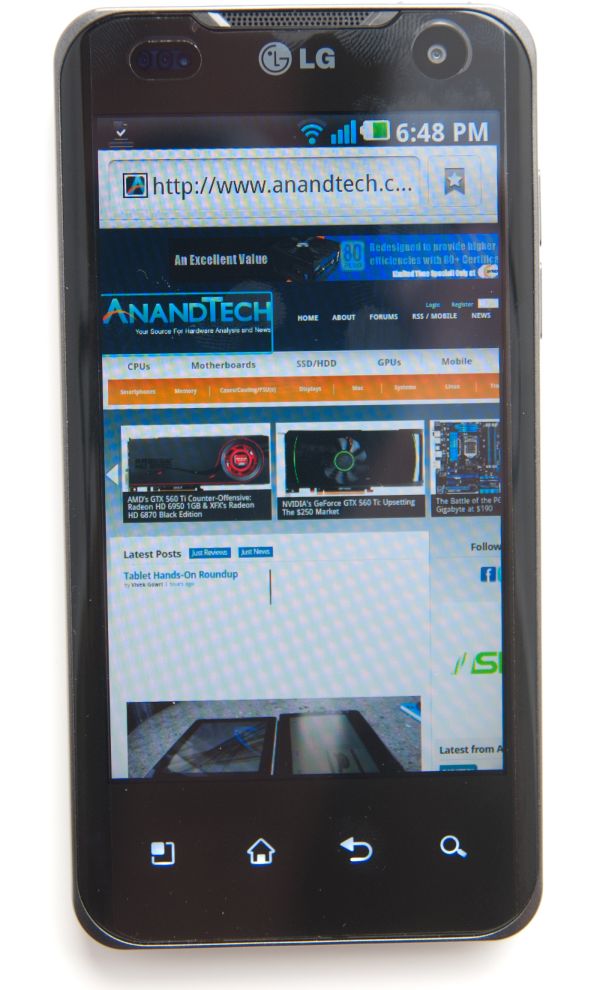This Just In: LG Optimus 2X, Our First Tegra 2 Smartphone
by Brian Klug on January 27, 2011 1:55 PM EST- Posted in
- This Just In
- Smartphones
- LG Optimus 2X
- Android
- Mobile
Update: Our full review is now live!
It's been 22 days since we saw the Tegra 2 packing LG Optimus 2X at CES, and just moments ago the device arrived at our doorsteps ready for a thorough reviewing. It's out of the box and charging now, ready to enter our battery life tests, but before that we managed to grab a bunch of photos and a few quick benchmarks.
First off, our model is European-spec and likewise came with a Type-C power adapter. Luckily we've got tons of microUSB chargers laying around. Our unit's packaging is definitely not final, as it came in just a black box with the accessories, but that's hardly an issue, what we're interested in is some Tegra 2 performance. Physical feel and appearance is almost exactly how we left it at CES.
Some quick benchmarks show Tegra 2 performance definitely leading in the browser area. Note that the Optimus 2X is shipping with Android 2.2.1. Gingerbread (2.3) was launched on Samsung's Hummingbird so it'll take a little while to port it over to NVIDIA's hardware. Honeycomb (3.0), on the other hand, will launch on Tegra 2 hardware once more.


Note that most of the performance advantage NVIDIA currently holds in these tests is between 12 - 25%. This implies that Qualcomm's 1.2GHz dual-core Snapdragon due out later this year could be performance competitive with NVIDIA's dual-core Cortex A9 Tegra 2. We still have a lot more benchmarking to do in order to properly characterize and understand NVIDIA's Tegra 2 performance in a smartphone however.
Linpack performance is a bit behind the latest from Qualcomm, but that's more telling of FPU performance and cache bandwidth than most real world smartphone apps:


We've got a lot more to run on the LG Optimus 2X, but so far it looks impressively speedy, just as expected.
Update: We've taken our usual video samples from the Optimus 2X, and uploaded them to YouTube and our own servers in a big (147 MB) zip. Full analysis will come with our larger review.

















28 Comments
View All Comments
jeffbui - Thursday, January 27, 2011 - link
Those synthetic benchmarks are entertaining if only for nostalgia's sake. Compare some of those numbers to your first computer.jeffbui - Thursday, January 27, 2011 - link
Here's a link:http://www.roylongbottom.org.uk/linpack%20results....
Ushio01 - Thursday, January 27, 2011 - link
Oh god I was using a pentium mmx 233 till 2004 and now it's surpassed by a phone chip.DanNeely - Thursday, January 27, 2011 - link
I didn't realize any of these benchmarks had been ported to Motorola 6809 architecture. :)The Hardcard - Friday, January 28, 2011 - link
Hey, you had a Coco too! I still have a Coco 3 in a box. Maybe I'll dig it out and run Linpack on it. How far behind a free feature phone do you think it is?Zokudu - Thursday, January 27, 2011 - link
Why does the system information list 1 core? I thought the big thing about Tegra 2 was that it was a dual core in addition to improved graphics capability.Brian Klug - Thursday, January 27, 2011 - link
I'm glad someone else saw that too ;)Quadrant only shows one core for some reason, but Tegra 2 is indeed dual core in this phone. Just one of the many things we're going to find out going forward is what's multithreaded and what isn't.
-Brian
pookguy88 - Thursday, January 27, 2011 - link
what carrier/frequencies does it have? I want it for T-Mobile!!BryanC - Thursday, January 27, 2011 - link
Your linpack binary doesn't appear to be parallelized - I'd expect linpack to scale well with the number of cores.Is your linpack written in Java? How about the version you run on the iPhone?
Brian Klug - Thursday, January 27, 2011 - link
We're using Linpack for Android: greenecomputing.com/apps/linpack/It's currently likely single threaded, but we're undergoing a learning process about what is and isn't mulithreaded in Android through Dalvik. We don't have a version of Linpack on the iPhone ;)
-Brian